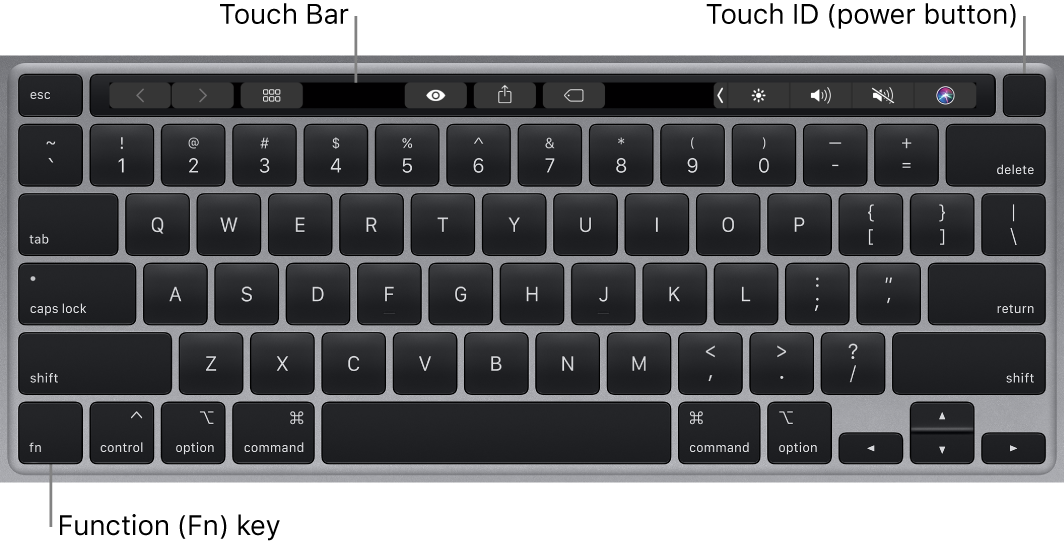MacBook Pro Magic Keyboard with Touch Bar and Touch ID
The Touch Bar at the top of the Magic Keyboard displays a set of tools that changes based on what you’re doing. Touch ID (the power button) is located on the right side of the Touch Bar. After you set up Touch ID, you can use your fingerprint to unlock MacBook Pro and make purchases from the iTunes Store, App Store, Apple TV app, and Book Store, and on websites using Apple Pay.

Use Touch ID (the power button). Press to turn on your MacBook Pro (or just lift the lid or press any key). When you first start up or restart, you need to log in by typing your password. You set up Touch ID during setup or later in the Touch ID pane of System Preferences. After setup, whenever you’re asked for your password after you first log in, you can place your finger lightly on the Touch ID sensor to authenticate instead of typing your password.
You can also use Touch ID to make secure online purchases with Apple Pay. For more information about Touch ID, see Set up your Mac. For more information about Apple Pay, see Use Apple Pay on your Mac.
Note: To turn off your MacBook Pro, choose Apple menu ![]() > Shut Down. To put your MacBook Pro to sleep, choose Apple menu
> Shut Down. To put your MacBook Pro to sleep, choose Apple menu ![]() > Sleep.
> Sleep.
All system functions are located in the Touch Bar.
Brightness buttons: Press
 or
or  to decrease or increase the brightness of the screen.
to decrease or increase the brightness of the screen.Mission Control button: Press
 to view what’s running on your MacBook Pro, including all your spaces and open windows.
to view what’s running on your MacBook Pro, including all your spaces and open windows.Launchpad button: Press
 to instantly see all the apps on your MacBook Pro. Click an app to open it.
to instantly see all the apps on your MacBook Pro. Click an app to open it.Keyboard illumination buttons: Press
 or
or  to decrease or increase the brightness of the keyboard.
to decrease or increase the brightness of the keyboard.Media buttons: Press
 to rewind,
to rewind,  to play or pause, or
to play or pause, or  to fast-forward a song, movie, or slideshow.
to fast-forward a song, movie, or slideshow.Mute button: Press
 to mute the sound from the built-in speakers or 3.5 mm headphone jack.
to mute the sound from the built-in speakers or 3.5 mm headphone jack.Volume buttons: Press
 or
or  to decrease or increase the volume of sound from the built-in speakers or 3.5 mm headphone jack.
to decrease or increase the volume of sound from the built-in speakers or 3.5 mm headphone jack.Function (Fn) key: Each function button (on the top row) can also perform other functions—for example, the F11 button can hide all open windows and show the desktop. Hold down the Fn key while you press a function button to trigger the action associated with the button.
Tip: Press the Fn key twice to turn on dictation, which lets you dictate text wherever you can type (for example, in Messages, Mail, Pages, and many other apps).
Set keyboard preferences. Use the Keyboard pane of System Preferences (choose Apple menu ![]() > System Preferences, click Keyboard, then click the buttons at the top to see the available options).
> System Preferences, click Keyboard, then click the buttons at the top to see the available options).
Learn about keyboard shortcuts. You can press key combinations to do things on your MacBook Pro that you’d normally do with a trackpad, mouse, or other device. For a list of commonly used shortcuts, see Keyboard shortcuts on your Mac.